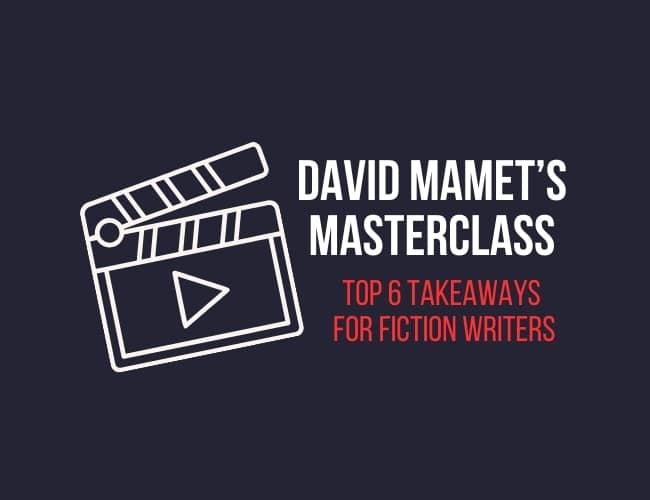As writers of fiction, we're always learning from more seasoned writers, whether it's through reading, film-viewing, or taking a class. Today, guest writer Nick Labonté reviews David Mamet's Masterclass on Dramatic Writing. See if it's the right online course for you!

David Mamet is a Pulitzer Prize-winning playwright, filmmaker, and author. He has been writing plays, screenplays, and books for decades. Some of his most well-known work includes Glengarry Glen Ross (Always Be Closing!), American Buffalo, and Heist.
In his writing class for Masterclass, Mamet breaks down his approach to writing with a focus on drama, but his advice can be applied to any project.
Note: this post contains Masterclass affiliate links, but they didn't influence Nick's review and they won't affect your price for Masterclass.
What does the Masterclass cover?
In the Masterclass, David Mamet Teaches Dramatic Writing, the Pulitzer Prize-winning writer covers just about every part of the craft of writing, from getting that initial draft done to narration and even how writers can best tell the truth in everything they write. The writing course is broken up into 26 lessons.
David Mamet Teaches Dramatic Writing
- Introduction
- The Purpose of Drama
- The Purpose of Drama (Cont’d)
- Dramatic Rules
- Dramatic Rules (Cont’d)
- Story Ideas
- Character
- Plot
- Structuring the Plot
- Structuring the Plot (Cont’d)
- Case Study: Structuring the Plot – American Buffalo
- Case Study: Structuring the Plot – Glengarry Glen Ross
- Dialogue
- Dialogue (Cont’d)
- Narration & Exposition
- Scenes
- Writing Process
- Writing Process (Cont’d)
- The Audience
- Lies & Truth
- Lies & Truth (Cont’d)
- Actors
- Actors (Cont’d)
- Life of a Dramatist
- Life of a Dramatist (Cont’d)
- Closing
Each session contains video lessons, practice, and advice not just for those writing for stage or film. Anyone writing fiction or working to improve their storytelling skills would benefit.
6 Takeaways from David Mamet’s Masterclass
I took David Mamet's Masterclass to learn from one of the great writers of our time and to see what advice on writing he offered that could improve my own writing skills. Here are my top 6 takeaways.
Your story is a line from point A to point B
In his Masterclass, Mamet emphasizes that plays—and other stories—have a beginning, a middle, and an end. Because that’s what makes a story work.
He later takes a blackboard and draws a line that goes from point A to point B. That’s your story.
That line isn’t necessarily straight, and in a great story, the story line shouldn’t be a smooth straight line. Incidents will cause that line to deviate or take a detour, but it always has to push toward that destination. Anything that doesn’t help push the story along that line is a distraction.
It takes practice to know exactly what’s a distraction and what’s just an interesting roadblock for your protagonist to go around. But over time you’ll get an eye for it.
Act two is muck (and the only way out is through)
Remember what it was like when you first started your current work in progress? Ideas flowed freely, you workshopped your opening chapter with other writers, and you were beyond excited to get started. Then you hit chapter two, and that excitement diminished every so slightly. By chapter 25 you’ve got your head in your hands, wondering why you’re even doing this.
That’s normal.
You’re not failing just because you’re struggling through your story’s second act. Figuring out point A and point B is the easy part. Connecting them is what they pay you the big bucks for.
You have to re-learn how to write plot for every new project
Figuring out how to build a plot that works is one of the toughest lessons for new writers to learn. It involves a lot of reading and breaking down what you read into its basic components. When it’s time to write your own, it involves a lot of notes, a lot of rewriting, and a lot of frustrated thinking—whether you’re a pantser or a plotter.
But the work’s not done once you’ve “figured it out” for your current project.
You have to learn it all over again on the next one.
Sometimes it’s because a lot of time passes between projects and you get a little rusty. But really it’s because every story is wildly different. It brings different problems, and you have to use different techniques to get the right solution.
At least it gets a little easier every time. It's encouraging to hear an accomplished writer grapple honestly with this idea that each story requires something a little more from you as a writer.
Each scene needs an incident that contributes to the story
When you’re reworking or rewriting your project, list out every single scene in your story. Then, go through them one by one, figuring out what their core incident is. That could be an important conversation between two characters, a piece of crucial information being revealed, or an event that completely changes things.
Now for every scene, ask yourself if that incident contributes to the story. Does it help push the plot along towards point B?
If it doesn’t, you need to take it out. Or, at the very least, integrate it with another scene that does push the story along.
One of the ways Mamet differentiates between good writers and bad writers is that good writers cut what the bad writers tend to keep. You can seriously improve your story by being just a bit more aggressive at the editing stage.
Exposition is excess flesh
Some exposition, especially in genres like fantasy and science fiction, is essential for helping your reader understand what’s going on, but it’s all too easy to go overboard. That’s why Mamet describes it as “excess flesh,” or something to cut away when you’re revising.
When you’ve spent a ton of time building your world, you’ll be tempted to share just about every detail about it with your reader. Resist this urge.
Mamet puts it succinctly in his Masterclass: “The question is ‘what can you do without?’ not ‘what can you put in?’”
There's no good place to start (just jump in and muck in)
Many newer writers do a ton of prep work before they start writing their stories. They may create detailed character portraits, plot out every scene, and make their writing nook extra cozy before they write a single word. But while some prep work is more than alright, too much prep might just be procrastination.
As Mamet puts it: “There are a lot of ways that people try to avoid the process, but at the end of the day you have to just write it down and deal with it being bad.”
No matter how much you prepare, your first draft is probably not going to be very good. Some writers shy away from actually putting words to paper—or to screen—because of that. But there’s no way to get around it: if you want to be a writer you have to write. There’s no perfect place to start, no perfect way to write that first draft. Just jump in with both feet. It’ll probably be bad. And that’s fine.
Ready to start? Check out Masterclass here.
Want to see our best reviews on other Masterclass offerings? Check these out:
Neil Gaiman Masterclass Review
Margaret Atwood Masterclass Review
Malcolm Gladwell Masterclass Review
Judy Blume Masterclass Review
Always Be Closing
It’s comforting to know that even a writer with a career like David Mamet’s gets stuck in the muck of Act 2. The advice about writing shared in his Masterclass is powerful stuff for writers at any stage of their journey, whether you’re just about to start your first project or you’re struggling through your 10th. Take the class, take notes, and you’ll see a marked improvement in your writing.
Have you taken a Masterclass? Which one is your favorite? Share in the comments.
 Nick Labonté writes out of the suburban sprawl around Toronto, usually on a powder-blue typewriter he snagged for $25. His fantasy and science fiction stories have been called dark, gory, and suspenseful by fans. When not writing, he can be found working on his lacklustre marksmanship skills or getting winded after chopping a few cords of wood. Fate's Conscripts is his first novel. Follow his writing journey at his website, Whiskey and Stardust.
Nick Labonté writes out of the suburban sprawl around Toronto, usually on a powder-blue typewriter he snagged for $25. His fantasy and science fiction stories have been called dark, gory, and suspenseful by fans. When not writing, he can be found working on his lacklustre marksmanship skills or getting winded after chopping a few cords of wood. Fate's Conscripts is his first novel. Follow his writing journey at his website, Whiskey and Stardust. PRACTICE
Set your timer for 15 minutes. Take your current work in progress, whether it’s at the outlining stage or you’re multiple rewrites into it. Write out Point A (your beginning) and Point B (your ending). Then, list out all the events in your story. Do they help push things along toward Point B? Or are they just distractions? Scratch out any scenes that don’t help move the story forward. You’ll want to consider either removing them from the story entirely or integrating them into other scenes.
Note: In character-driven stories, scenes don’t necessarily need to push the plot forward, but they do need to push character development forward.
When you're finished, share your story in the Pro Practice Workshop for feedback from the community. And if you share, please be sure to comment on a few stories by other writers.
This article is by a guest blogger. Would you like to write for The Write Practice? Check out our guest post guidelines.



0 Comments